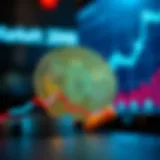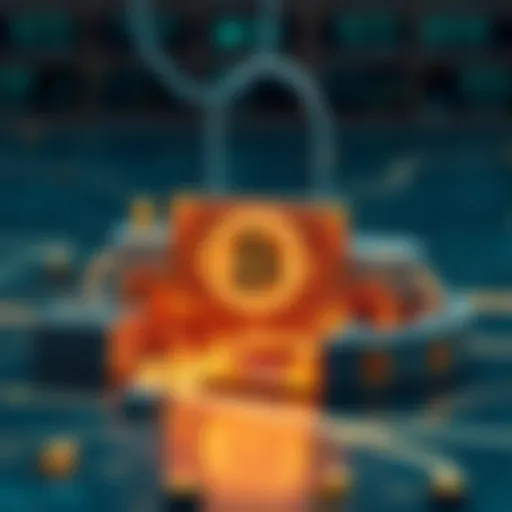Understanding Minted NFTs and Their Impact on Digital Ownership


Intro
In the age of digital transformation, understanding minted NFTs has become vital, especially for those eyeing investment or innovation in this arena. NFTs, or non-fungible tokens, are fundamentally different from cryptocurrencies like Bitcoin or Ethereum. They serve as unique digital assets on a blockchain, representing ownership of a specific item or piece of content. The term minting refers to the process of creating these digital assets, marking them as distinct and traceable on the blockchain.
As we delve into the intricacies of minted NFTs, we aim to shed light on their technical underpinnings and real-world applications. From the world of art to gaming and even intellectual property, NFTs are revolutionizing how we perceive ownership, creativity, and value in the digital landscape. Whether you are a budding investor perturbed by market volatility or an educator trying to explain complex concepts, this article will provide a comprehensive overview of minted NFTs, ensuring clarity and depth in our discourse.
What is Minted NFT?
Minted NFTs, or Non-Fungible Tokens that have been created on a blockchain, represent a paradigm shift in how we perceive ownership, value, and creativity in the digital realm. The importance of understanding minted NFTs lies in their transformative potential across various industries. By enabling individual ownership of digital assets, minted NFTs provide a groundbreaking method for artists, gamers, and entrepreneurs to safeguard their creations and ensure they reap the rewards of their talents.
Defining NFT
NFTs, or Non-Fungible Tokens, are distinct digital assets backed by blockchain technology. Unlike cryptocurrencies such as Bitcoin or Ethereum, which are interchangeable and hold identical value, NFTs possess unique identifiers that distinguish one from another. This concept of uniqueness is what gives NFTs their value. An NFT can be anything from digital artwork to music, videos, and in-game items.
The defining characteristic of NFTs is their inability to be replicated or exchanged on a one-to-one basis. This means that an artist can mint a digital painting as an NFT, effectively providing a certificate of authenticity, which cannot be copied or tampered with. This idea mirrors the art world where an original painting holds more value than any replica. Therefore, NFTs are essentially certificates of ownership embedded within a digital landscape, enabling creators to showcase and monetize their work.
The Process of Minting
Minting an NFT is the act of transforming a digital file into a token on the blockchain, a process not unlike stamping a coin with a unique design. While this may seem straightforward, several technical steps are involved.
- Choosing a Blockchain: The first step in minting an NFT is selecting the blockchain that will host it. Ethereum is the most popular choice due to its robust infrastructure for NFTs, but other blockchains like Binance Smart Chain, Flow, or Tezos are also viable.
- Creating a Digital Wallet: Before you can mint an NFT, you need a digital wallet that supports the selected blockchain. Wallets like MetaMask or Trust Wallet store your tokens and facilitate transactions.
- Selecting a Marketplace: Not every NFT will be best suited for every marketplace. Platforms like OpenSea, Rarible, and Foundation cater to different audiences and asset types, determining where and how you wish to sell your minted NFT.
- Uploading the Digital Asset: Once you have a wallet and a marketplace, you can upload your digital file. This file could be an image, video, or other digital mediums. During this process, you will often have to input relevant details, such as title, description, and any additional attributes that can enhance the appeal of the NFT.
- Minting the NFT: Finally, you initiate the minting process, usually by paying a gas fee to record the transaction on the blockchain. Once the transaction is confirmed, your NFT is officially created and can now be bought, sold, or traded.
Minting serves as the bridge between the physical concept of collectibles and the digital landscape. It allows ownership to be as tangible in the virtual space as it is in the real world. This new era challenges previous notions of scarcity and value, making understanding minted NFTs not only important but essential for anyone navigating today's increasingly digital environment.
Understanding minted NFTs is crucial to grasp their implications on ownership and value dynamics in the digital age.
History of NFTs
The journey of non-fungible tokens, better known as NFTs, adds layers of complexity indeed. Understanding this history is pivotal for grasping their current significance and future potential in the digital realm. NFTs, unlike traditional cryptocurrencies, are distinctive assets—each bearing unique traits that set them apart from one another. The historical timeline of NFTs depicts a fascinating evolution that mirrors shifts in technology, culture, and even economics. This section of the article helps illuminate the progression that led us to the burgeoning marketplace we see today.
Origin of Non-Fungible Tokens
The genesis of non-fungible tokens can be traced back to the advent of blockchain technology. In its early days, the blockchain merely represented the backbone of cryptocurrency like Bitcoin. However, a small project called CryptoPunks — featuring 10,000 unique pixelated characters — can be credited with laying the groundwork for NFTs as we know them today. Launched by Larva Labs in 2017, this project was groundbreaking in that each character possessed different attributes and rarity levels. Historically, these tokens signaled a significant shift from fungible assets to distinct digital items.
"The birth of decentralized ownership coincides with the initial launch of NFTs, reflecting a profound cultural change in how we perceive value in the digital sphere."
Furthermore, the emergence of Ethereum as a blockchain supporting smart contracts revolutionized the NFT landscape. With Ethereum's ERC-721 standard introduced in late 2017, creators found themselves equipped with tools to encode ownership and provenance of digital assets into the blockchain. This was ground zero for a burgeoning marketplace where art, music, and even tweets could be tokenized as one-of-a-kind creations.
Evolution of NFT Marketplaces
Following the roots of NFT creation, we must consider how marketplaces evolved, offering a platform for buying, selling, and trading these unique digital assets. Early on, the landscape was relatively simple, often relying on DIY websites or forums. However, as interest grew, dedicated marketplaces sprang up, such as OpenSea and Rarible, enhancing accessibility for buyers and creators alike.
These platforms allowed individuals not just to sell but also to discover a veritable smorgasbord of digital art. Artists and developers recognized the potential to monetize their creativity, providing a direct link to consumers without the middleman. The ability to sell directly facilitated the rare opportunity for artists to earn royalties on secondary sales — a boon that traditional art markets rarely offer.
As these marketplaces flourished, so did the range of NFTs available. The rise of game-based NFTs, like Axie Infinity, showcased how interactivity could elevate value, transforming these tokens from simple collectibles into integral components of gameplay.
Technological Framework Behind NFTs
Understanding the technological framework that supports minted NFTs is essential for examining their impact on various industries. This framework, which combines blockchain technology with smart contracts, forms the foundation of non-fungible tokens (NFTs) and offers a multitude of benefits. As we delve deeper into these components, we will discover how they contribute to the growing significance of NFTs in today's digital landscape and what considerations must be taken into account.
Blockchain Technology
Blockchain technology is the backbone of all blockchain applications including NFTs. At its core, a blockchain is a decentralized ledger that records transactions across many computers in such a way that the registered transactions cannot be altered retroactively without the consensus of the network. This feature is what provides NFTs with their unique qualities. Each NFT is registered on a blockchain, allowing it to be distinctive and easily verifiable.


- Decentralization: The decentralization aspect means that no single entity controls the entire network. This adds a layer of security against censorship and fraud. When an NFT is minted, it resides on a network that is not controlled by any single authority, which also lends credibility to the ownership of the asset.
- Transparency: Every transaction made with NFTs is recorded on the blockchain, making it transparent. Buyers and sellers can trace the complete history of an asset, including its previous owners. This reduces the likelihood of disputes concerning provenance, which is particularly important in the art world.
- Security: Security is paramount in the digital age, and the cryptographic techniques used in blockchain technology provide a secure environment for NFTs. Each asset has a unique cryptographic hash that links it to its previous states, thus ensuring that originality is maintained.
In summary, blockchain technology establishes a reliable ecosystem for NFTs, where security, transparency, and decentralization keep the system robust. Despite its many advantages, challenges concerning scalability and energy consumption continue to lurk beneath the surface, often raising eyebrows among environmental advocates.
Smart Contracts in NFT Minting
Smart contracts play a pivotal role in the minting process of NFTs. They are executable agreements that run on the blockchain, automating and enforcing the terms of a contract without the need for intermediaries. When it comes to minting NFTs, smart contracts integrate several functions that enhance the overall utility of the tokens.
- Automation of Processes: Smart contracts automate various tasks, such as transferring ownership when a sale occurs. When an NFT is purchased, the smart contract executes the transaction instantly, enabling a smooth exchange between parties.
- Royalty Mechanisms: Many smart contracts allow for built-in royalty structures, which automatically distribute a percentage of future sales back to the original creator. This innovation is revolutionary for artists and creators, as it ensures they receive continual compensation for their work as it is resold over time.
- Customizability: Smart contracts can also be programmed with specific rules and stipulations that govern the use of an NFT. For instance, a creator can specify that their artwork can only be displayed in certain metaverses or that it may not be altered without permission.
"The intersection of blockchain and smart contracts delivers an innovative approach to ownership, setting the stage for a new era in digital asset management."
By effectively harnessing the strengths of blockchain technology and smart contracts, the minting of NFTs transforms the landscape of digital ownership. As we continue to explore this field, it becomes clear that technological advancements will only deepen the relationship between creators and their audiences, reshaping how art and intellectual property are perceived in the digital age.
Use Cases for Minted NFTs
The concept of minted NFTs is not just a fleeting trend; they have found a firm footing across various industries, reshaping the way we perceive ownership and value in the digital realm. In the context of this article, we delve into fundamental applications of minted NFTs, paying special attention to what makes these use cases not only relevant but also transformative.
Art and Collectibles
In the world of art, NFTs are changing the game. Traditionally, owning art meant physical possession—hanging a painting on the wall, or keeping a sculpture in a gallery. However, minted NFTs break down these barriers. Artists often mint their works as NFTs, allowing for verifiable ownership on the blockchain. Buyers can now acquire a digital piece that carries authenticity.
Consider an artist who creates stunning digital wallpapers. By minting these as NFTs, the artist can not only sell them but also embed royalties into the smart contract. This means if the artwork changes hands in the future, the artist still earns a percentage from each subsequent sale.
- Authenticity: Unlike physical art, an NFT can prove ownership and originality in a way that is tamper-proof.
- Global Reach: Artists can market their creations to anyone around the globe, reaching a broader audience than ever before.
- Scarcity: By limiting the number of NFTs minted from a particular artwork, artists can artificially create scarcity, thereby increasing value.
This shift has created a thriving marketplace for both established and emerging artists, allowing buyer and seller alike to reap rewards in a way that fits our modern, digital lifestyle.
Gaming and Virtual Worlds
Gaming is another field ripe for the adoption of minted NFTs. In this space, the idea of ownership transcends the game itself. Players can own unique in-game assets, from weapons to skins and even the virtual land on which their characters roam.
Take a popular game like Axie Infinity. Players can breed, trade, and battle digital creatures known as Axies. Each Axie is a unique NFT, providing players a solid investment as well as entertainment. If a player decides to sell a powerful Axie, they can do so seamlessly, transferring ownership via blockchain technology.
- Interoperability: NFTs can potentially move from one game to another, giving them a value that extends beyond a single application.
- True Ownership: Players retain ownership of their assets, allowing for a secondary market that can be highly lucrative.
- Play-to-Earn Models: Through NFT integration, players can earn real money by simply playing games, turning leisure activities into revenue streams.
These elements make the gaming industry a promising landscape for the evolution of NFTs, fueling innovations that continuously engage and inspire gamers around the world.
Intellectual Property and Licensing
Minted NFTs also serve an essential role in the realm of intellectual property and licensing. They offer a straightforward way to license digital content while maintaining a clear proof of ownership. This works to protect creators and businesses alike from unauthorized use of their materials.
For example, a filmmaker may mint NFTs of their film stills, allowing others to use these images in a licensing model. Each use would trigger a smart contract that stipulates how much the creator earns for their work. This opens new revenue streams and simplifies the often complicated issues surrounding content licensing.
- Enforcement of Rights: Smart contracts can automatically enforce rules about the use of the creative work, reducing disputes.
- Transparency: The ownership details are available and transparent on the blockchain for all to see, eliminating gray areas.
- Access to New Markets: Creators can reach users or businesses looking to license content without traditional middlemen.
By integrating NFTs into intellectual property, industries can create a more efficient and fair approach to licensing.
"The practicality of minted NFTs is not merely a curiosity; they are paving the way for a restructured economy in ownership and use."
From art to gaming, and beyond, the uses of minted NFTs provide a glimpse into a future where digital ownership takes on new forms and the manner in which we value creativity grows ever richer.
Benefits of Minting NFTs
Minting NFTs has gained traction in recent years, and the benefits are hard to ignore. It’s like opening a treasure chest filled with opportunities for artists, creators, and even businesses. Overall, minted NFTs not only empower creators but also add layers of transparency and authenticity in the digital world. Let's delve into some key advantages that make minting NFTs a game-changer.


Proof of Ownership
One of the standout features of minted NFTs is the proof of ownership they provide. This aspect is incredibly relevant in today’s digital age, where rights to digital content can often be murky. When someone mints an NFT, a unique token is created on the blockchain, registering the ownership of that particular digital asset. This can range from artwork to music, giving creators a solid claim over their work.
In a world where copying and sharing might dilute authenticity, this proof is vital. Imagine an artist who spends hours crafting a digital painting. With a minted NFT, they can demonstrate that they are the original creator. This not only protects their work but also establishes a clear chain of provenance. The ability to track ownership through the blockchain offers a level of security that’s hard to find elsewhere.
"Owning a minted NFT is like holding a certificate of authenticity for a rare painting."
Attribution and Royalties
Another significant benefit of minting NFTs revolves around attribution and royalties. In traditional art markets, it’s not uncommon for an artist to sell their work and never see another dime from its resale. However, minted NFTs allow creators to program royalties directly into the smart contracts. This means that every time the NFT changes hands, a percentage of the sale can automatically go back to the original creator.
This change transforms the way artists and creators approach their work. There’s a sense of security knowing that even if their work becomes highly valued later on, they will still benefit financially. It serves as a powerful incentive for artists to enter the digital space. The potential for ongoing income streams has made NFTs an appealing avenue for many in the creative industry.
To give you an idea:
- Immediate Ownership: Creators see a return right after their work is sold.
- Long-Term Benefits: Artists gain from secondary sales, thus incentivising continued engagement with their audience.
Challenges in the NFT Landscape
As the NFT market continues to gain momentum, it faces various challenges that could hinder its potential for growth and acceptance. Understanding these challenges is crucial for investors, developers, and enthusiasts alike, as it helps them navigate the landscape more effectively. It also encourages proactive measures to enhance security and sustainability in the space. This section delves into two significant hurdles: environmental concerns and the risk of fraud and scams.
Environmental Concerns
In recent years, the environmental impact of minting NFTs has come under scrutiny. Most NFTs are created on blockchain platforms that rely on proof-of-work protocols, which require substantial computational power and energy. Take Ethereum, for example. Its energy consumption is comparable to that of entire countries, raising alarms among environmental activists. Some criticize the NFT space for contributing to climate change, and this awareness might push potential buyers and creators to reconsider their participation.
Concerns about carbon footprints have spurred debates about sustainability. A growing number of consumers and investors are seeking greener alternatives in their digital transactions. Solutions like shifting to proof-of-stake mechanisms or utilizing more eco-friendly blockchains are being explored.
"With great innovation comes great responsibility." The industry must address these environmental issues effectively. Here are a few key points to consider:
- Blockchain Selection: Choosing blockchains that implement eco-friendly protocols can mitigate adverse effects.
- Carbon Offsetting: Some platforms are adopting strategies to offset their carbon footprints through various means, such as purchasing carbon credits.
- Community Initiatives: Collaborations with environmental organizations can enhance awareness and promote sustainability within the NFT ecosystem.
These initiatives represent steps toward a more sustainable NFT landscape, yet skeptics remain. Thus, improving public perception is essential for the longevity of NFTs.
Fraud and Scams
With the NFT market's rapid expansion, the presence of fraudulent activities has also skyrocketed. Cybercriminals often take advantage of the lack of regulations and the anonymity that blockchain offers, which can be a double-edged sword. From fake listings to illegitimate sales, scams range in sophistication. This reality instills doubt among inexperienced buyers, who may hesitate to engage with the NFT market altogether.
It's vital for stakeholders to adopt stringent security measures to protect their assets and investments. Here are some common schemes to stay wary of:
- Counterfeit NFTs: Scammers may list NFTs that don’t actually have the creator's approval, leading innocent buyers to purchase imitations.
- Rug Pulls: This situation occurs when developers abandon a project suddenly, taking the investors' funds with them. It's essential to perform due diligence before investing in new projects.
- Phishing Attacks: Cybercriminals may try to access users' wallets through phishing schemes, often posing as legitimate entities.
To combat these challenges, users are encouraged to:
- Research Thoroughly: Understanding who the creator is and the history behind a project is vital.
- Use Reputable Platforms: Not all marketplaces are created equal. Established platforms often offer better security.
- Secure Wallets: Keeping NFTs in secure wallets instead of exchanges or connected applications adds an extra layer of protection.
In summary, while challenges like environmental concerns and fraud threaten to undermine the NFT market, understanding and addressing these issues can pave the way for progress and establish a more reliable ecosystem for everyone involved.
Minting NFTs: The Practical Steps
Minting NFTs is not just a technical process; it holds significant implications for artists, creators, and investors alike. This section delves into the various steps involved in minting NFTs, offering a step-by-step guide on choosing a blockchain, selecting a marketplace, and crafting the digital asset. Understanding these components is critical. Not only does it empower creators to effectively navigate the NFT landscape, but it also ensures that they are making informed decisions that could impact their success and the value of their digital assets.
Choosing a Blockchain
The very first step in minting an NFT is selecting the underlying blockchain. This decision determines the NFT's functionality, interoperability, and potential market reach. While Ethereum remains the most famous choice due to its robust smart contracts, other options like Binance Smart Chain, Tezos, and Flow are increasingly becoming popular. Each blockchain has its unique characteristics that can impact factors like transaction fees and speed of minting.


- Ethereum: Known for its extensive ecosystem but comes with higher gas fees.
- Binance Smart Chain: An alternative with lower fees and compatibility with Binance’s extensive user base.
- Tezos: Offers a more environmentally friendly option due to its proof-of-stake consensus.
- Flow: Designed for mass-market applications, particularly in gaming and collectibles.
Choose wisely, as the blockchain you pick can either enhance or limit your NFT's success in the crowded digital market.
Selecting a Marketplace
Once you've decided on a blockchain, the next step is selecting a marketplace. Each marketplace has its nuances, often focusing on specific audiences or types of NFTs. For instance, OpenSea is a general marketplace that allows for a variety of NFT types, while platforms like Rarible cater more towards creators who want more control over their sales.
When choosing a marketplace, consider:
- User base: A larger audience increases exposure.
- Fees: Different marketplaces charge varying fees for minting and selling.
- Community and Support: Some platforms have more robust communities and support systems than others, which could be beneficial for new creators.
- Curation and Quality Control: Some marketplaces curate their listings to ensure quality, which might help your NFT gain more attention.
Selecting the right marketplace is crucial for defining your NFT’s journey from creation to sale.
Crafting the Digital Asset
Finally, the actual crafting of your digital asset is where your creativity shines. This stage is not just about uploading your digital work; it's about encapsulating your vision and how it connects with potential buyers. When crafting your NFT, keep these aspects in mind:
- File Format: Typical formats include images (JPEG, PNG), videos (MP4), and audio files. Each format may have different impact factors on the value.
- Metadata: Incorporate rich metadata that describes your asset. This can include title, description, and even links to additional resources or the story behind the piece.
- Limited Editions: Decide how many editions of your NFT you wish to mint. Limited quantities can drive demand, so consider strategies that play into scarcity.
- Visual Appeal: Ensure your asset stands out in crowded marketplaces. Good design and presentation can draw in potential buyers.
In this competitive environment, crafting a unique and engaging digital asset can potentially enhance your NFT’s perceived value.
"The journey of minting NFTs is not just technical; it’s about storytelling and creating a substantial connection between the artist and the audience."
Understanding these practical steps can make all the difference in a creator's NFT journey. By carefully choosing the right blockchain, marketplace, and crafting compelling digital assets, creators can significantly enhance their chances of success in the NFT arena.
The Future of Minted NFTs
The landscape of minted NFTs is evolving at a breakneck pace. As technology advances and societal attitudes shift, understanding the future of minted NFTs becomes paramount. This section will delve into the forthcoming innovations and regulatory considerations that are likely to shape the NFT market. The emphasis is not just on predicting trends but comprehending their implications on investors, creators, and users alike.
Innovations on the Horizon
The trajectory of minted NFTs is closely tied to various innovations that could reshape how they are utilized. Some noteworthy developments include:
- Interoperability: Future minted NFTs may cross platforms due to enhanced blockchain interoperability. Imagine owning a digital art piece that you can display in multiple metaverses without hassle. This interoperability could create vibrant ecosystems where assets move freely.
- Augmented Reality (AR) and Virtual Reality (VR): Integrating NFTs into AR and VR will likely transform how we perceive ownership, especially in virtual worlds and gaming. Picture a scenario where virtual real estate or collectibles become part of an immersive experience, bridging the gap between digital and physical realms.
- Fractional Ownership: This intriguing concept allows multiple individuals to own a fraction of an NFT. It might democratize access to high-value digital art or rare collectibles. For instance, instead of paying millions for a single artwork, several investors can own shares, making art investment more accessible.
- Enhanced Utility: As the technology matures, the functionalities associated with NFTs will grow. Future minted NFTs might offer additional features, such as online event access, exclusive content, or even physical goods tied to the digital asset. Such traits could greatly enhance their appeal.
"The future of NFTs isn't just about ownership; it's about unlocking new avenues for creativity and engagement."
Potential Regulatory Developments
As minted NFTs continue gaining traction, they will not escape the watchful eye of regulators. Various potential regulatory developments loom on the horizon, including:
- Taxation Framework: Governments might implement specific tax policies concerning NFT transactions. Owners and creators alike could be impacted by new tax brackets depending on the sale of NFTs, which may alter investor behaviors drastically.
- Consumer Protection Laws: As NFTs become mainstream, discussions around consumer rights and protection will intensify. Regulators might enact measures to safeguard buyers from fraud or predatory practices in the NFT space.
- Anti-Money Laundering (AML) and Know Your Customer (KYC) regulations: These could become more prevalent in NFT marketplaces to curb illicit activities. As these protocols gain enforcement, the anonymity typically associated with cryptocurrencies could diminish, reshaping how transactions are conducted.
- Intellectual Property Rights: There's a growing call for clarity regarding the ownership rights associated with minted NFTs. As creators seek to protect their intellectual property, regulators will need to establish clear laws, ensuring both artists and buyers understand their rights and responsibilities.
Culmination
The significance of understanding minted NFTs cannot be overstated. The advent of non-fungible tokens has revolutionized various sectors, from art to digital ownership. This conclusion aims to underscore the vital takeaway from our exploration, emphasizing both the benefits and considerations surrounding minted NFTs.
First and foremost, minted NFTs serve as definitive proof of ownership. This characteristic is not just a theoretical concept; it’s a practical aspect that fosters trust in digital transactions. Artists and creators now have a mechanism to confirm their rights and receive compensation for their work, thanks to the transparent nature of blockchain technology. This represents a paradigm shift—moving from the traditional, often opaque avenues of ownership to a more transparent ecosystem.
Moreover, we have discussed the attribution of royalties, which plays a crucial role in fair financial compensations for creators over time. Minted NFTs can provide continuous revenue through secondary sales, ensuring that artists and creators do not miss out on profits as their work appreciates in value. This ongoing support structure has prompted an upsurge in creative expression, benefitting both artists and investors alike.
However, with great innovation also comes challenges. The environmental concerns related to blockchain technology must be addressed seriously. As the market expands, the need for sustainable practices becomes more pressing. Additionally, the potential for fraud and scams poses a significant risk that investors and creators must navigate carefully. Due diligence, research, and awareness become essential tools in this evolving landscape.
In summary, an understanding of minted NFTs allows participants to appreciate their profound implications in our digital world. As we embrace this new era, it’s important to consider both the opportunities for individual empowerment and the potential hurdles lying ahead. Awareness and adaptability will be key to thriving in this dynamic environment.
"The future is no longer something we enter. The future is something we create." – Leonard I. Sweet
Key Takeaways
- Proof of Ownership: Minted NFTs provide a secure and verifiable method of establishing ownership in the digital realm, ensuring that artists can protect their intellectual property.
- Royalty Attribution: Creators benefit from an innovative royalty structure that allows for ongoing income from secondary sales, aligning the incentives of artists and investors.
- Environmental Awareness: As the NFT market expands, it's crucial to consider the environmental impact and seek solutions for sustainable blockchain practices.
- Navigating Risks: Understanding potential fraud and scams is essential for protecting investments and fostering trust in the NFT market.















